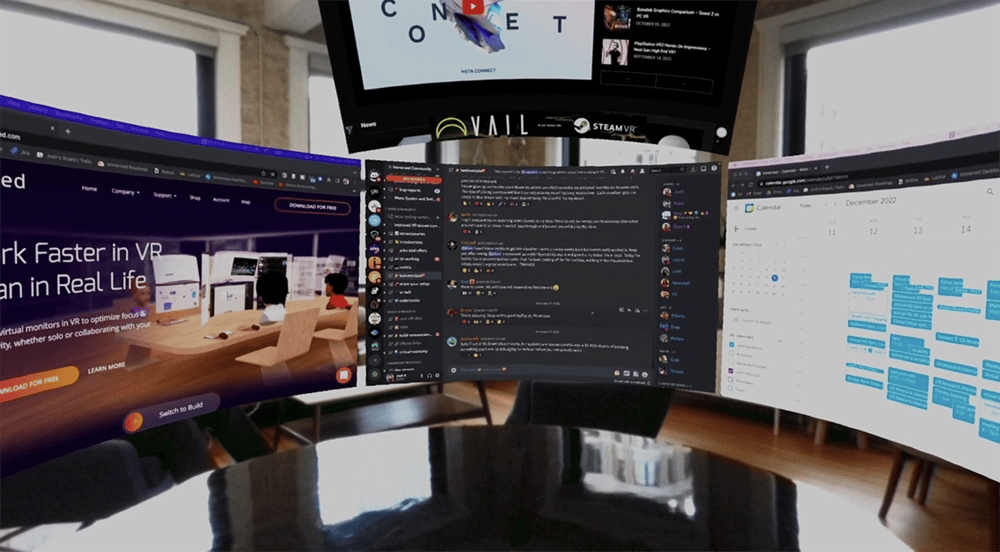In a rapidly evolving digital world, the concept of the Metaverse is gaining momentum and becoming a hot topic of discussion across various sectors, especially in the realm of cybersecurity. With the advent of this immersive digital universe, questions about security, identity, and privacy arise, echoing the challenges we face in our physical reality.
This month, we've been fielding numerous questions, particularly about cybersecurity, especially how it pertains to the metaverse. As we explore this path, it's essential to address some fundamental aspects.
In this blog you will find:
🛡️ What is the importance of cybersecurity in the Corporate Metaverse?
⚠️ What are some Major Cyber Threats in the Metaverse?
What is the Metaverse?
First and foremost, we must revisit the question: What is the Metaverse? We reemphasize this because our conversation today, which is centered on cybersecurity, is directly linked to our understanding of the Metaverse. Furthermore, as technology matures and new developments emerge, the definition of the Metaverse continues to evolve. For instance, with the unveiling of Apple's new devices just last week, the Metaverse's definition is bound to undergo further modifications as we move forward.

For us at LineZero, we perceive the Metaverse as a form of mixed reality. You might be using a device or encountering technology that is either augmenting reality, i.e., superimposing technology as an overlay on real life, or offering a virtual reality experience where you fully immerse yourself into the technology. Essentially, this involves eliminating the physical layer of the real world. So that's our working definition of the Metaverse, if you will, and its importance can't be overstated.
What is the importance of cybersecurity in the Corporate Metaverse?
So, what is the significance of cybersecurity in the Corporate Metaverse? There are several factors to consider here. Currently, in traditional cybersecurity, the primary concern is identity - how someone's identity could be compromised or how credentials could be used to access sensitive information or systems. This concern is just as, if not more, prevalent in the Metaverse due to the unique nuances it brings along.

We have to consider identity from an individual's perspective - could the Metaverse be used as an attack vector to gain access to your corporate credentials, and therefore, indirectly gain entry into your business operations? Another aspect to consider is the risk of corporate identity theft, especially in the context of deep fakes and other advancing technologies. As avatars in the Metaverse become more realistic, there's a possibility that technology could capture the essence of these avatars and use them for identity theft, posing a risk to your corporate environment. This is an area that demands our attention and proactive thinking.
What are some Major Cyber Threats in the Metaverse?
There are also concerns about potential brand theft and the misuse of your organization's identity within the Metaverse. Let's consider an example - you're a retailer creating a Metaverse version of your physical store, maybe in some sort of virtual shopping mall. Just as in a physical space, we need to ensure your brand is protected.

For instance, there could be individuals who intend to vandalize your virtual store, somewhat akin to graffiti in the real world. This could range from harmless pranks aiming to cause minor damage to more serious threats where others may attempt to hijack your platform or brand to further their message, such as activist groups. Therefore, brand reputation and the considerations that exist in the physical world remain relevant in the Metaverse. We need to consider these elements but with a focus on the impact of technology in the Metaverse environment.
There are three primary cyber threats encountered in the Metaverse:
-
Identity Theft: This involves the misuse of personal or corporate identities to compromise information or systems.
-
Brand Reputation Damage: Misuse or harm to a company's brand in the Metaverse could affect how it is perceived in the real world.
-
Misinformation: The Metaverse could be misused to spread unverified or false information, making it challenging to discern truth from fiction.
These threats require heightened vigilance and the implementation of safeguards, similar to those in the physical world.
It can be hard to distinguish between authoritative and non-authoritative information, and we must remain vigilant about our actions in response to the information we receive. Just as we would take precautions in the physical world, the Metaverse requires similar safeguards. For example, consider a situation where an employee reaches out to change their banking information for payroll purposes. In the Metaverse, this interaction might happen with a seemingly trustworthy avatar, leading one to believe they're dealing with a real person. However, we still need checks and balances in place to validate information and prevent misuse. Ensuring that our responses and actions within the Metaverse are based on verified and authentic information is of paramount importance.
Best Practices for Implementing Cybersecurity in the Metaverse
Now let's consider some recommended best practices for implementing cybersecurity in the Metaverse. As it's still early days for the Metaverse, there's a lot that will evolve over time. However, some principles and safeguards that we apply in the physical world remain relevant in the digital realm as well.
Firstly, any information request or change to profiles should be subjected to rigorous validation checks. It's essential to ensure the requests are both authentic and appropriate. Next, vigilantly follow best practices to protect your corporate identity. Ensure that when a user logs into or authenticates into the Metaverse, it can't serve as a gateway into your other systems.
Effectively, you should adhere to the standard security best practices that you already implement, but with an increased level of attention and intentionality. When considering any action, think about potential risks and if necessary, consult with your technology team to prepare against those eventualities.
Conclusion
As we stand on the precipice of a new era, the Metaverse offers endless possibilities for innovation and advancement. However, it's crucial to remain vigilant about the unique cyber threats it presents. By transferring the rigor of cybersecurity measures from our physical world to this expansive digital realm, we can foster a safer, more secure Metaverse. The cybersecurity landscape in the Metaverse is in its infancy, but with a proactive and intentional approach, we can navigate it effectively. As always, the team at Line Zero is here to provide guidance and answer your questions on this journey into the future of the digital world. Feel free to reach out at engage@linezero.com for further discussions. As we step together into the Metaverse, let's ensure our footprints are both innovative and secure.
Tags:
Corporate Metaverse
June 09, 2023




Comments